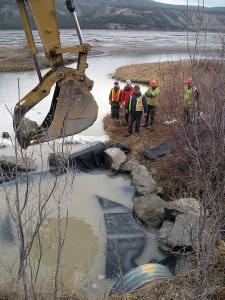
This year, Parks Canada is restoring two culverts to improve fish passage and aquatic connectivity. Work is planned for both the Mile 9 culvert on Highway 16 (18 km east of the Town of Jasper), and at Whistler Creek on Highway 93 (5 km south of Jasper).
The water level below these culverts will be raised by creating step pools below the culvert. To do this, the culvert will be blocked off, and water diverted to allow an excavator to place rock around the outlet of the culvert to raise the water levels.
Once the creek is allowed to flow through again, raised water levels will then eliminate the existing drop and reduce the velocity of the water to allow for fish to pass through.
Steep or hanging culverts can fragment aquatic ecosystems by hindering the passage of fish and other species. Hanging culverts create an impassable physical drop; while steep culverts create a velocity barrier where the water passes through the culvert faster than a fish can swim, making it impossible for them to get through. These access barriers between lakes and streams mean that fish and other aquatic life can’t move freely up and down the waterways as they would naturally.
Culvert restoration at Mile 9 is expected to start this week, and should take one to two weeks to complete. During this time, a construction speed zone will be in place, and there may be occasional lane closures as trucks enter and leave the highway. Main restoration work at Whistler Creek will not proceed until this fall after the design is complete, but highway crews may carry out a day of erosion protection beforehand.
Similar aquatic restoration projects have been successfully completed in the park in the past five years and include bridges installed along the Celestine Lake Road and step pools created at the Talbot Lake and Edna Lake outlets on Highway 16.
River bank protection in advance of a new Fifth Bridge
Since the high water levels of 2012, Parks Canada has been working on the design and construction of a new, permanent Fifth Bridge at Maligne Canyon. In preparation for this new bridge, a Parks Canada contractor is now working to stabilize and protect the banks of the Maligne River site. Work will continue until mid-April, as local fish populations are least likely to be affected during this time period. Over the next few weeks, parking may be limited by equipment and construction material.
If conditions remain favourable, construction of the new bridge is anticipated to take place this summer between mid-June and mid-August.
The temporary winter footbridge will soon need to be removed before spring run-off, but access to canyon trails will still be available from the upper end at the Maligne Teahouse or from the bottom end at the Sixth Bridge. Check the trail conditions report at www.pc.gc.ca/jaspertrails for the most recent trail news.

Please cry wolf!
The last member of the Signal wolf pack has become quite the celebrity.
Visitors and locals have been enjoying its recent public appearances and using those occasions to capture great photos. While it is a truly special experience to glimpse Jasper’s animals in the wild, this wolf’s behaviour is becoming a concern.
Black with a white patch on its chest, the wolf has been frequently spotted near town and along the adjacent roadways; it shows little concern for vehicles and people, putting it at risk of being hit on the highway or of becoming a public safety concern.
Please help us protect this wolf. If you see it or other predators (wolves, coyotes, cougars and bears), contact dispatch immediately at 780-852-6155. Remember: keep your distance, travel smart—be prepared, and keep dogs on leash.
Parks Canada
Special to the Fitzhugh
